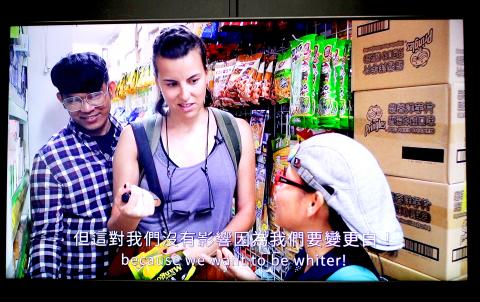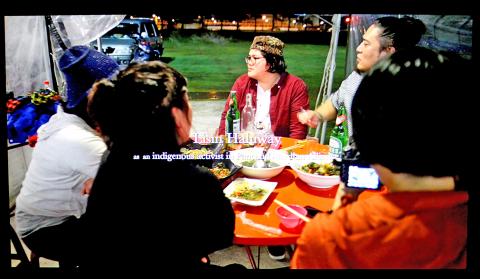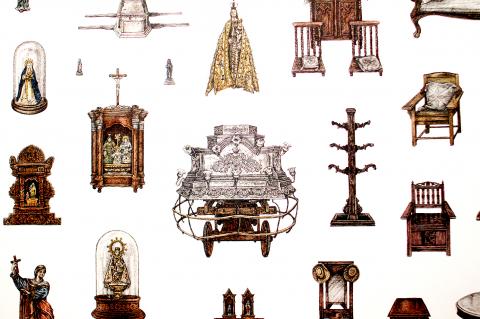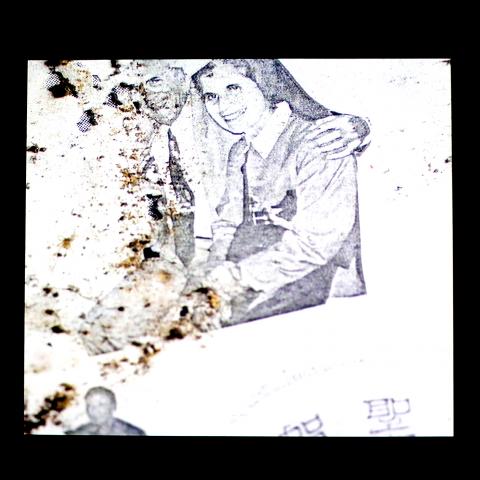Why did you come to Taiwan? (台灣!我來了), a new group show at the Museum of Contemporary Art, Taipei (MOCA, Taipei), is a modern-day examination of identity and migration through the legacy of Spanish colonizers who settled on the northern tip of Taiwan, which they called Formosa, for a brief period in the 17th century.
Though compact compared to the museum’s current main exhibition, Once Upon a Time: Unfinished Progressive Past (少年當代 — 未終結的過去進行式), which looks at youth culture from the 1950s to the 1980s, Why did you come to Taiwan? works as a companion piece with a few promising takes on the country’s colonial past and, more importantly, how it continues into the present.
The title comes from an exclamation made by Salvador Diaz, a historical figure captured by the Dutch to serve as translator during their conquest of Formosa. Taking his cue from Diaz, curator Cheng Shao-hung (程少鴻) invites three artists from Spain and the Philippines and two local artists to respond to colonialism.

Photo: Davina Tham, Taipei Times
Barbara Sanchez Barroso’s documentary short film, Far from Formosa, sees the Spanish artist on a tour of Taipei’s “Little Manila,” a stretch of Zhongshan North Road (中山北路) frequented by the Filipino community that is bound by Saint Christopher’s Church to the north and a one-stop department store to the south.
This is a living, breathing ethnic enclave, and Barroso’s guides, whom she also interviews, are two Filipinos who have transcended the economic pressures that initially brought them to Taiwan: Sherry Macmod Wang, a former domestic helper turned labor rights activist, and Mario Subeldia, the first migrant laborer to receive an artist’s license here.
As descendants of the former colonizer and the colonized, the trio’s encounter produces some moments of insight and constructive discomfort. Walking through the toiletries aisle of a Filipino supermarket, Wang takes the opportunity to explain to a surprised Barroso her country’s obsession with whitening products and light skin as a mark of beauty.

Photo: Davina Tham, Taipei Times
But the work never really delves into the tension inherent in the trio’s relationship and the significance of their meeting in Taiwan, beyond brief mentions of the ignorance of most Spaniards today about Spanish Formosa and questions about the labor rights of migrant workers here. Barroso offers outward curiosity, but little inward inquiry.
For introspection and vulnerability, head to Lee Tzu-tung’s (李紫彤) art video, Writing the Time Lag (時差書寫), which the artist has been filming since 2014. Lee looks at transformations in gender and national identity through Taiwan’s Aboriginal and independence movements.
Backed by an all-female crew, Lee’s interviews become a safe space in which her respondents explore their roles as victims and aggressors. One Aboriginal activist recounts a sexual assault by an older male relative who, after the act was complete, told her, “See, you’re a natural.” Another activist for the Formosan Association for Public Affairs — a Han Chinese woman like Tzu — feels her complicity in past injustices and envies the relationship that Aboriginal communities have to the land and country of Taiwan, which is “without sin.”

Photo: Davina Tham, Taipei Times
Clocking in at a headspinning 70 minutes, with uneven sound levels and intermittent subtitles, Writing the Time Lag can be a difficult work to take in. But Lee does arguably the most honest and soul-searching work of the exhibition, and is an intriguing discovery.
Kao Chun-hung (高俊宏), a more established artist, has two art videos from Sister Ding — But We Never Preach in Spain (丁修女 — 但是我們從來不會去西班牙傳教), which originally showed at last year’s Keelung Harbor Biennale. The work melds ethnographic, historical and paranormal inquiry of two interweaving strands: the ruins of a Spanish abbey on Keelung’s Peace Island (和平島) and its history as told by present-day residents; and the life of Sister Elvira Valentin Martin, a Spanish missionary who served patients with Hansen’s disease, or leprosy, at Losheng (Happy Life) Sanatorium for more than 60 years.
Filipino artist Henrielle Baltazar Pagkaliwangan sheds light on the history of another Asian colony in Beyond the Boxer Codex, an illustrated inventory of artifacts still in use in the Philippines, which the Spaniards introduced during its more than 300 years of settlement. There is no mention of Taiwan in this work, but the objects drawn — from farming tools and furniture, to swords and gilded Catholic figurines — show how colonial violence took on a range of guises and evokes ambivalence toward the colonial legacy, and in fact prompts thinking about local nostalgia for the Japanese colonial era.

Photo: Davina Tham, Taipei Times
Spanish-Welsh artist Rafael Perez Evan rounds out the exhibition with The Devil’s Bird, Ornithomancy, which deploys virtual reality (VR) technology to recreate the lost Truku art of divination from the behaviors of birds in the wild. The VR experience, which suspends the viewer in a rainforest with only a bird for company, respects the beauty and majesty of that setting.
As a coda to the exhibition, the work strikes a crucial ending note, eerily straddling a past in which the future of Taiwan’s people — as settlers, colonial subjects and diplomatic pariahs — had yet to unfold, and a present in which technology and knowledge are more widely available than ever before, but are still not enough to reconcile the violence inflicted on personal and national identities.
EXHIBITION NOTES
What: Why did you come to Taiwan?
When: Until Sep. 29. Open Tuesdays to Sundays from 10am to 6pm
Where: Museum of Contemporary Art Taipei (台北當代藝術館), 39, Changan W Rd, Taipei City (台北市長安西路39號)
Admission: NT$50
On the Net: mocataipei.org.tw

May 18 to May 24 Pastor Yang Hsu’s (楊煦) congregation was shocked upon seeing the land he chose to build his orphanage. It was surrounded by mountains on three sides, and the only way to access it was to cross a river by foot. The soil was poor due to runoff, and large rocks strewn across the plot prevented much from growing. In addition, there was no running water or electricity. But it was all Yang could afford. He and his Indigenous Atayal wife Lin Feng-ying (林鳳英) had already been caring for 24 orphans in their home, and they were in

On May 2, Chinese Nationalist Party (KMT) Chairman Eric Chu (朱立倫), at a meeting in support of Taipei city councilors at party headquarters, compared President William Lai (賴清德) to Hitler. Chu claimed that unlike any other democracy worldwide in history, no other leader was rooting out opposing parties like Lai and the Democratic Progressive Party (DPP). That his statements are wildly inaccurate was not the point. It was a rallying cry, not a history lesson. This was intentional to provoke the international diplomatic community into a response, which was promptly provided. Both the German and Israeli offices issued statements on Facebook

Even by the standards of Ukraine’s International Legion, which comprises volunteers from over 55 countries, Han has an unusual backstory. Born in Taichung, he grew up in Costa Rica — then one of Taiwan’s diplomatic allies — where a relative worked for the embassy. After attending an American international high school in San Jose, Costa Rica’s capital, Han — who prefers to use only his given name for OPSEC (operations security) reasons — moved to the US in his teens. He attended Penn State University before returning to Taiwan to work in the semiconductor industry in Kaohsiung, where he

President William Lai (賴清德) yesterday delivered an address marking the first anniversary of his presidency. In the speech, Lai affirmed Taiwan’s global role in technology, trade and security. He announced economic and national security initiatives, and emphasized democratic values and cross-party cooperation. The following is the full text of his speech: Yesterday, outside of Beida Elementary School in New Taipei City’s Sanxia District (三峽), there was a major traffic accident that, sadly, claimed several lives and resulted in multiple injuries. The Executive Yuan immediately formed a task force, and last night I personally visited the victims in hospital. Central government agencies and the